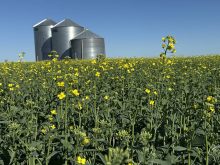Wheat will be the big loser in the acreage race this spring if seeding
and moisture conditions are normal, forecasts Agriculture Canada.
But analysts think that normal looks increasingly unlikely this spring.
“It’s a really high-risk year,” said Alberta Agriculture grain market
analyst Charlie Pearson.
“We know we’re going in dry.”
Agriculture Canada’s World and Canadian Market Outlook for Grains and
Oilseeds in 2002-03 forecasts slightly higher wheat prices, slightly
lower durum prices, higher flax prices but lower prices for barley,
Read Also

Huge Black Sea flax crop to provide stiff competition
Russia and Kazakhstan harvested huge flax crops and will be providing stiff competition in China and the EU.
canola and oats.
While durum, barley, oats and canola are forecast to fall in price,
those commodities will still bring a good return, just not as good as
the sometimes record prices this past year.
Wheat will lose acreage to durum, barley and oats because of the
comparatively better returns on those commodities. It will also face
pressure from canola and special crops.
“They’ll raid from wheat,” said Pearson.
Analysts are sketching out scenarios, based on different moisture
conditions, of what farmers will seed this spring and how that will
affect prices.
Canadian Wheat Board market analyst Bruce Burnett said he agrees with
the forecast of more durum, barley and other non-spring wheat if there
is adequate soil moisture by seeding time.
“That area has to come out of somewhere, and that’s the spring wheat
area,” said Burnett.
But if farmers head out into dry fields they’ll be tempted to seed
wheat, which tends to be tougher than other crops during a drought.
“This year wheat held up pretty well,” said Burnett.
“That’s the tradeoff farmers are thinking about right now. Some special
crops may have a chance at better returns, but at what risk?”
With adequate subsoil moisture, farmers can take more risks in a dry
spring. But if the subsoil is dry and there is no spring moisture then
farmers are more likely to shift their acreage, Pearson said.
“Everybody will be working through their budgets right now, looking at
their break-evens and what will return them the best profit,” he said.
Fortunately the tense situation on the Prairies is shared with other
parts of the world wheat market. World stocks are comparatively low
right now, so a major weather problem anywhere could shock markets and
might drive prices up.
So if prairie farmers can get a good crop seeded and harvested, they
may benefit from someone else’s problems more than they usually do.
“It’s going to be a fun and interesting year,” said Pearson.
“There is some optimism.”
Some buyers will be offering attractive prices for forward contracts
for certain crops because of the low world supplies for many
commodities. That will build security for some farmers.
“We need an almost perfect year here and around the world” to avoid a
shortage somewhere, said Pearson.
Agriculture Canada analyst Fred Oleson said the production forecast for
the Prairies is tentative because soil moisture conditions are so bad.
“With the way the weather is progressing here, it is getting to be
questionable how realistic any of our expectations are,” he said.
The same goes for the world price outlook.
“World stocks of wheat are significantly lower than they were last
year, so the world production patterns will be dependent on weather
conditions. Prices will be much more sensitive to weather.”
While it’s “very tough” to forecast market prices and seeding
intentions this early, Oleson said analysts have to begin somewhere.
“To a large extent it just gets people thinking about 02-03,” said
Oleson.

















